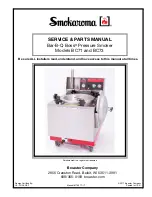
D.
OPERATION.
SAFETY MESSAGE TO OPERATORS OF
FEDERAL SIGNAL ELECTRONIC SIRENS
AND LIGHT/SOUND SYSTEMS
WARNING
The lives of people depend on your safe operation
of Federal products. It is important to read and
follow all instructions shipped with the products.
In addition, listed below are some other important
safety instructions and precautions you should
follow:
Qualifications
•
To properly use an electronic siren and speaker(s):
you must have a good understanding of general
vehicle operation, a high proficiency in the use of
safety warning equipment, and thorough knowl-
edge of state and federal UNIFORM TRAFFIC
CODES.
Sound Hazards
•
Your hearing and the hearing of others, in or close
to your emergency vehicle, could be damaged by
loud sounds. This can occur from short exposures
to very loud sounds, or from longer exposures to
moderately loud sounds. For hearing conservation
guidance, refer to federal, state, or local recommen-
dations. OSHA Standard 1910.95 offers guidance
on “Permissible Noise Exposure.”
•
All effective sirens and horns produce loud sounds
(120 dB) that may cause permanent hearing loss.
Always minimize your exposure to siren sound, roll
up your windows and wear hearing protection. Do
not sound the siren indoors or in enclosed areas
where you and others will be exposed to the sound.
Only use the siren for emergency response situa-
tions.
Sound Limitations
•
Before using the vehicle, check to see if the siren
speakers are concealed from view. If the siren
speaker is not in clear view on the front of the
vehicle, use extra caution when operating the
vehicle. A concealed siren speaker installation is
less effective at warning others.
•
Maximum sound output will be severely reduced if
any objects are in front of the speaker. If your
installation has obstructions in front of the
speaker, drive even more cautiously.
•
Frequently inspect the speaker to ensure that it is
clear of any obstruction, such as mud or snow,
which will reduce maximum sound output.
Signaling Limitations
•
Be aware that the use of your visual and audible
signaling devices does not give you the right to
force your way through traffic. Your emergency
lights, siren, and actions are REQUESTING the
right-of-way.
•
Although your warning system is operating
properly, it may not alert everyone. People may not
hear, see, or heed your warning signal. You must
recognize this fact and continue driving cautiously.
•
Situations may occur which obstruct your warning
signal when natural or man-made objects are
between your vehicle and others. This can also
occur when you raise your hood or trunk lid. If
these situations occur, be especially careful.
Driving Limitations
•
At the start of your shift, you should ensure that
the light/sound system is securely attached to the
vehicle and operating properly.
•
If the unique combination of emergency vehicle
equipment installed in your vehicle has resulted in
the siren controls being installed in a position that
does not allow you to operate them by touch only,
OPERATE CONTROLS ONLY WHILE YOUR
VEHICLE IS STOPPED.
•
If driving conditions require your full attention,
you should avoid operating the siren controls while
the vehicle is in motion.
Continuing Education
•
File these instructions in a safe place and refer to
them periodically. Give a copy of these instructions
to new recruits and trainees.
Failure to follow these safety precautions may result
in property damage, serious injury, or death to you, to
passengers, or to others.
Refer to the instructions packed with the electronic
siren for operation.
-3-






















